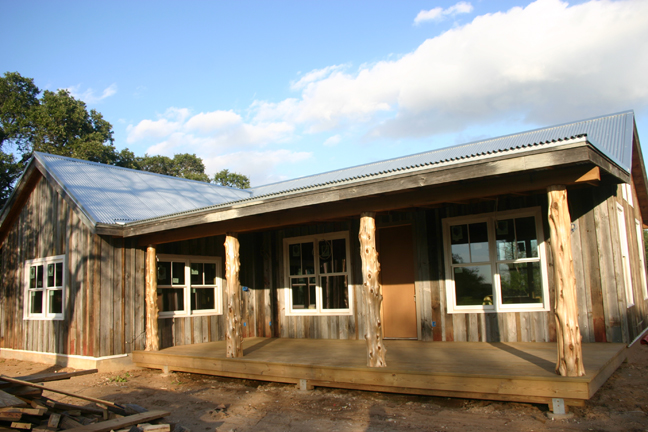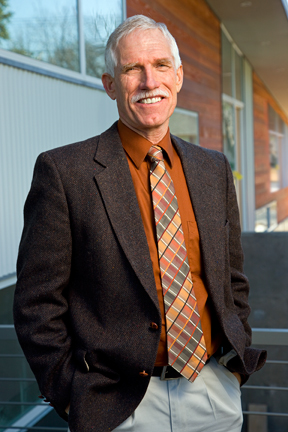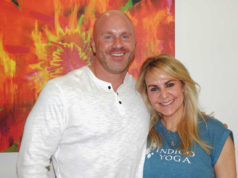On a bluff above Eagle Mountain Lake sits a rustic-looking house in the final stages of construction. The frame “casita” (Spanish for small house) looks like a simple Old- West cabin. In fact it’s an ambitious project that could be the archetype for the future of “green” home building.
This is the Net Zero Energy Casita – meaning that it will produce as much energy as it uses, and it’s being built by Ferrier Custom Homes, which specializes in environmentally sensitive construction. The 1,500-square-foot house, powered in part by a 45-foot-tall wind turbine, will function as a second home for a Fort Worth family.
 Fort Worth builder Don Ferrier, founder and owner of Ferrier Custom Homes, has won numerous awards for his green building practices. Building green is no longer a pipe dream, he said – he and other local builders believe that the zero net energy model could be viable for inner-city neighborhoods.
Fort Worth builder Don Ferrier, founder and owner of Ferrier Custom Homes, has won numerous awards for his green building practices. Building green is no longer a pipe dream, he said – he and other local builders believe that the zero net energy model could be viable for inner-city neighborhoods.
“Many said that this would be a little niche, and we’re delighted to see it’s blossomed so well,” said Ferrier, who is known in some circles as the “Godfather of Green.”
In 2005, “green” homes represented about 2 percent of the residential market in this country, or about $7 billion worth of construction, according to Triplepundit, an environmental news web site. By 2008 the green share had grown to between 6 and 10 percent of the market. Over the next five years, the environmental news site predicted, if the overall construction outlook improves as expected, green homebuilding could double its share of the market again.
Ferrier is dreaming big with regard to green inner-city homes. He is waiting for a list of lots that the city wants to sell – properties where homes were condemned and the lots seized for unpaid taxes and penalties for things like unmowed grass. When he gets the list, he said, he will look into building a net zero energy enclave in a neighborhood such as Terrell Heights, or the Fairmount Historical District.
In the meantime, he believes the Zero Energy Casita will act as proof of the viability of green homebuilding.
“Net zero energy” homes use wind and solar power, weather-shielded windows, metal roofs that reflect the sun, reclaimed wood and siding, and insulated interior panels that minimize sound as well as maximizing energy efficiency. Ferrier is also using green materials, meaning products that are recycled, harvested from renewable resources, and reusable and recyclable. Excess building material from green projects is mostly recycled or reused in some way.
The cost of using green materials is a little higher, said Ferrier, but those costs are usually recovered within a few years, through savings on utilities
 “We’ve had several folks wanting to build a net zero home,” he said. “You’re going to consume energy off the grid, but you’re going to put energy back into the grid.”
“We’ve had several folks wanting to build a net zero home,” he said. “You’re going to consume energy off the grid, but you’re going to put energy back into the grid.”
When the combination of wind and solar power isn’t enough to operate the Casita, it will utilize energy from a local electric company. But given the home’s high elevation and proximity to the lake, wind shouldn’t be hard to come by, said the builder.
The owner of the Casita said that he never intended to buy a net zero energy home, though he wanted to go “light green.” But the tax incentives and rebates convinced him it was worth the extra effort.
“I wasn’t looking to build a green home,” said the owner, who asked that his name not be used. “The process just took us down that path. It made good investment sense.”
He said that because his family will not be living in the casita full time, the offsetting of higher green materials costs via utility savings will take a little longer, perhaps seven to 10 years.
Ferrier said that the other “green” homes he has built cost between $130 and $270 per square foot. Custom homes can range anywhere from $100 to $300 per square foot, depending on the neighborhood. However, costs to heat and cool his homes are usually about a third of the costs in a similarly sized traditional home, he said.
His company’s entrée into affordable green homes was spurred by his daughter’s efforts five years ago. Heather’s Home, as the project was known, was an effort to build the greenest home possible on a budget. The approximately 2,000-square-foot house near Lake Weatherford used green materials, solar energy, and insulated panels – and almost achieves the net zero energy goal. Their efforts netted them a Fort Worth Weekly “Best” award in 2005 for architectural design.
Ferrier’s company is developing what will be the area’s first net zero energy subdivision, in Flower Mound. Construction will begin next year on The Rheudasil Farms development, named after the city’s first mayor.
Ferrier said that he tried to build in the Fairmount area, but the restrictions of that neighborhood’s historical overlay made designing difficult. His company built a green home in the nearby Ryan Place neighborhood that was featured in the neighborhood’s Christmas tour of homes last year.
Dennis Shingleton, chairman of the Fort Worth Sustainable Development Task Force, said he is excited by Ferrier’s project and hopes to make the Casita the poster home for sustainable residential development.
“It would be nice if in some form or fashion [the city] could provide incentives [for other people to duplicate] his efforts,” he said. The task force “certainly can recognize his efforts, if they prove to be as laudable as they sound,” he said.
Ferrier is not the only builder going green, though he was one of the first. Jyl DeHaven runs Green Urban Development, a Fort Worth green-building consulting firm that has begun construction on a commercial building in Sweetwater, in West Texas, that will actually put more energy back into the grid than it uses. The project is the restoration of an almost 90-year-old building on the town square. The structure, of 18,000 to 20,000 square feet, will house offices.
“We’ve gone down a very similar path on an old building in Sweetwater that will actually blend solar, wind, and geothermal,” said DeHaven. The extra energy will be credited to a local nonprofit group, she said.
DeHaven said that profitability is still the key for green developers, but tax incentives make achieving that a lot easier.
“For us, being on the commercial side, it is always driven by revenue. It still has to make economic sense,” she said. “It means looking at a different way to equate value. Historically, value has always been in dollars, and this building will not have utility bills. The payback for us will be under five years.”
Financial viability is one of the reasons that Ferrier said he might be looking to buy lots in the severely depressed Near Southeast area of Fort Worth.
“I would love to get [four or five] lots in a row [in the Near Southeast], create a little enclave of net zero energy homes,” he said. He said he put down a deposit on a lot on Lipscomb Street in the Fairmount area that costs $35,000 but has seen similar lots on the other side of I-35 going for $5,000.
“What if we could make our own little gated community down there?” he said. “We’re still looking for a way to do it and actively pursuing a way to make it happen. We’re waiting to see what lots the city has to sell.”











[…] Green House – On a bluff above … as a second home for a Fort Worth family. Fort Worth builder Don Ferrier, founder and owner of Ferrier Custom Homes, has won numerous awards for his green building practices. Building green is no longer a pipe dream, he said … […]